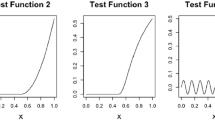Abstract
In a dose finding study the aim is to come up with a safe and efficient drug administration. By comparing the estimated tolerance limits of the concentrations with a predetermined desired interval, that is, the therapeutic window, one may be able to adjust the drug dosage to attain a large proportion of the population within the window. For drugs with a therapeutic window situated at high concentrations close to toxic levels, one has to achieve a balance between attaining a large proportion of the population at efficiently high levels on one hand and the risks of an overdose on the other hand. In such cases, it is important to use the proper estimation approach for the upper tolerance limit. Here, the conservative estimation approach intended for a drug with potentially adverse side effects is compared with the expectation approach intended for a drug with harmless side effects. It is shown in an example that the expectation approach can be considerably more efficient when used in the latter case, an advantage that is rarely discussed when proposing estimators.
Similar content being viewed by others
References
Rowland M, Tozer TN. Clinical Pharmacokinetics: Concepts and Applications. London: Williams & Wilkins; 1995.
Mee RW. Normal-distribution tolerance limits for stratified random samples. Technometrics. 1989;31(1):99–105.
Guttman I. Tolerance regions, statistical. In: Kotz S, Johnson NL, eds. Encyclopedia of Statistical Sciences. Volume 9. New York: Wiley & Sons; 1982;272–287.
Wilks SS. Mathematical Statistics. New York, NY: Wiley & Sons; 1962.
Wald A. An extension of Wilks’ method for setting tolerance limits. Ann Math Stat. 1943;14:45–55.
Tukey JW. Non-parametric estimation II: Statistically equivalent blocks and tolerance regions—the continuous case. Ann Math Stat. 1947;18:529–539.
Nickens DJ. Using tolerance limits to evaluate laboratory data. Drug Inf J. 1998;32(1):261–269.
Wilks SS. Determination of sample sizes for setting tolerance limits. Ann Math Stat. 1941;12:91–96.
Food and Drug Administration. Draft Guideline on Statistical Principles for Clinical Trials. FDA Federal Register, 1997: vol. 62 no. 90, 25712–25726.
Gillespie JA, Srinivasan R. Distribution-free simultaneous outer and inner tolerance limits for screening and descriptive purposes. Comm Stat-Theory Methods. 1994;23(5): 1357–1364.
Author information
Authors and Affiliations
Corresponding author
Rights and permissions
About this article
Cite this article
Petzold, M. A Comparative Study of Some Approaches for Estimating Tolerance Limits. Ther Innov Regul Sci 35, 1013–1018 (2001). https://doi.org/10.1177/009286150103500340
Published:
Issue Date:
DOI: https://doi.org/10.1177/009286150103500340




